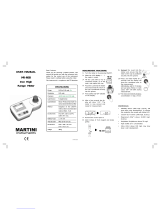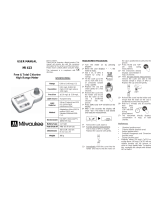Hanna Instruments Turbidity & Chlorine Measurements HI 93114 User manual
- Category
- Measuring, testing & control
- Type
- User manual
This manual is also suitable for
Hanna Instruments Turbidity & Chlorine Measurements HI 93114 is a portable device for water quality analysis that measures turbidity, free and total chlorine. It's ideal for potable water measurements and can be used for a variety of applications, including:
- Environmental monitoring
- Water treatment
- Food and beverage industry
- Laboratory analysis
The HI 93114 is easy to use and features a large dual-level display that shows the measured parameter and current mode. It also has a user-selectable auto-off function to conserve battery life.
Hanna Instruments Turbidity & Chlorine Measurements HI 93114 is a portable device for water quality analysis that measures turbidity, free and total chlorine. It's ideal for potable water measurements and can be used for a variety of applications, including:
- Environmental monitoring
- Water treatment
- Food and beverage industry
- Laboratory analysis
The HI 93114 is easy to use and features a large dual-level display that shows the measured parameter and current mode. It also has a user-selectable auto-off function to conserve battery life.



















-
 1
1
-
 2
2
-
 3
3
-
 4
4
-
 5
5
-
 6
6
-
 7
7
-
 8
8
-
 9
9
-
 10
10
-
 11
11
-
 12
12
-
 13
13
-
 14
14
-
 15
15
-
 16
16
-
 17
17
-
 18
18
-
 19
19
Hanna Instruments Turbidity & Chlorine Measurements HI 93114 User manual
- Category
- Measuring, testing & control
- Type
- User manual
- This manual is also suitable for
Hanna Instruments Turbidity & Chlorine Measurements HI 93114 is a portable device for water quality analysis that measures turbidity, free and total chlorine. It's ideal for potable water measurements and can be used for a variety of applications, including:
- Environmental monitoring
- Water treatment
- Food and beverage industry
- Laboratory analysis
The HI 93114 is easy to use and features a large dual-level display that shows the measured parameter and current mode. It also has a user-selectable auto-off function to conserve battery life.
Ask a question and I''ll find the answer in the document
Finding information in a document is now easier with AI
Related papers
-
Hanna Instruments HI93703 Owner's manual
-
Hanna HI 96771C Owner's manual
-
Hanna HA96717 Owner's manual
-
Hanna Instruments HI 93702 User manual
-
Hanna Instruments HI 3831T Owner's manual
-
Hanna Instruments HI93703-11 Owner's manual
-
Hanna Instruments HI93414-01 Owner's manual
-
Hanna Instruments HI 93746 User manual
-
Hanna Instruments HI 98811 User manual
-
Hanna Instruments HI38017 Owner's manual
Other documents
-
Milwaukee MI 404 User manual
-
 Martini Instruments MI 408 User manual
Martini Instruments MI 408 User manual
-
Milwaukee MI 406 User manual
-
Milwaukee MI408 User manual
-
 Martini Instruments MI 413 User manual
Martini Instruments MI 413 User manual
-
Milwaukee MI413 User manual
-
Milwaukee MI414 User manual
-
Milwaukee MI411 User manual
-
Milwaukee MI 413 User manual
-
Milwaukee MI406 User manual




















